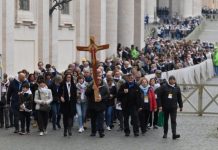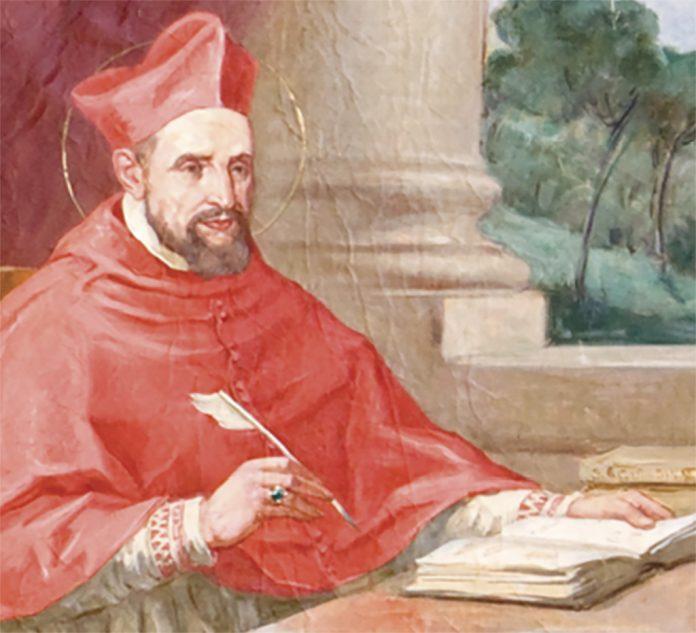On November 4th, the memory of St.Charles Borromeo is celebrated. At a crucial moment in which many truths of the Faith were being questioned, it fell to the Archbishop of Milan to defend them from the attacks of heresy and to personify the model of sanctity for the Catholic Episcopate.
Newsdesk (04/11/2024 15:45, Gaudium Press)Violent storms battered the Church over the course of the sixteenth century. The marvellous edifice of Christianity now displayed deep rifts caused by the tepidity of its sons, and had become the target of attacks aimed at demolishing it.
It was no longer a matter of confronting external enemies, but rather of Christians bent on rending asunder the seamless tunic of Catholicism. The faithful, hitherto united as a single flock under the aegis of one shepherd, listened with amazement at the cry of insubordination uttered by Luther against the Chair of Truth, and entire nations departed from the fold of the Holy See in consequence.
It was not long before other notables such as Calvin and Zwingli followed the reckless monk of Wittenberg in preaching heretical doctrines, which at first seemed at variance with one another. All of them, however, aimed at the same objective: “The religious innovators were in agreement solely regarding the complete oppression and extirpation of Catholic worship.”1
It was at this crucial crossroads in the history of the Church that a host of illustrious heroes of the Faith arose, characterized by renewed love for that which frivolous minds of the time had scorned: the decorum of the Sacred Liturgy, the frequent and proper reception and distribution of the Sacraments, the solid doctrinal formation of the clergy and the faithful.
Birth accompanied by signs in the heavens
St. Charles Borromeo occupied a prominent post at this juncture, his decisive feats condensed into a brief life of forty-six years. God seems to have placed on the shoulders of this just man a hefty portion of the Church’s concerns, while showering with blessings all the works carried out through his pastoral zeal.
A beautiful episode is associated with his birth during the early morning hours of October 2, 1538. The Borromeo family castle, located in the Lombard city of Arona, on the shores of the limpid Lake Maggiore, became suddenly illuminated by a bright light which descended from the firmament, and remained over the site for several hours.
Various witnesses attested to the fact, as is related in the Saint’s bull of canonization: “On the night of the boy’s birth, the Lord manifested the splendour of his future sanctity with an intense and extraordinary light, which many people saw shining over the mother’s chamber.”2
Little Charles was baptized a few days later in the castle’s chapel, and from an early age he stood out for his marked religious leaning. As he grew, he revealed the virtues of his noble lineage, combining within an affable personality the features of an upright, coherent spirit, endowed with a prodigious capacity for work and governance.
When the time for higher studies arrived, Charles Borromeo left for Pavia, where he studied Ecclesiastical and Civil Law. On the eve of obtaining his doctoral title, news arrived that would completely change his life: his maternal uncle, Giovanni Angelo de Medici, elected to the Chair of Peter in the Conclave of 1559, summoned him to assist him in the guidance of the Church, appointing him Cardinal-Deacon, before he had even been ordained priest.
“Guardian Angel” of Pius IV and Archbishop of Milan
Pius IV was cognizant of his nephew’s virtues, which were at the root of the apparently excessive honours and appointments which he did not hesitate to confer on him. While it is true that Charles Borromeo accrued prestigious offices, it must be acknowledged that this was a rare example of successful nepotism, for “from the first day, he was the antithesis of the typical cardinal-nephews of the Renaissance, who were real bon vivants in most cases.”3 It is known that his presence displeased some members of the Pope’s entourage, because “the strict way of life and thoroughly ecclesiastical sentiments of Charles were in no way to the liking of these people.”4
It is difficult to measure what the Church gained with his presence at the Pope’s side, for, in addition to being a valuable and sagacious assistant in every good work, this “guardian angel” of flesh and blood was a self-sacrificing man who took on the most difficult duties, the most complicated questions, the problems that others shunned, never moved by the slightest personal interest.
Three years after being appointed Secretary of State, St. Charles Borromeo was ordained a priest in September of 1563, and, in the month of December he was raised to the episcopal dignity. However, before this, he had been designated as administrator of the Archbishopric of Milan, already at that time the largest ecclesiastical jurisdiction on the Italian Peninsula.
The government of this Archdiocese imposed upon him the grave obligation to labour for the sanctification of a large flock, beset with every kind of spiritual and material need, to which the Saint dedicated more attention than to several other weighty undertakings.
The decisions of Trent take on life in Milan
In the same year of 1563, the pontifical decision to conclude the Council of Trent, begun eighteen years earlier under the auspices of Paul III, created a stir both within and without the ecclesial sphere. The sessions of this great assembly became an efficacious instrument for unveiling and combating the errors of Protestantism, through a renewed and enriched affirmation of Catholic doctrine.
St. Charles Borromeo played an important role in this context. He did not go to Trent, nor was he one of the conciliar fathers, although the drawing up of the monumental Roman Catechism was carried out under his direction.
Nevertheless, he was active at the highest levels in making the final sessions a reality, and in creating conditions for the decrees of the great assembly to be fully recognized by the entire Church. To obtain this goal, his personal effort was of great influence.
With the death of Pius IV in December of 1565 and the election of the Dominican Antonio Michele Ghislieri – none other than St. Pius V – in the following January, the government of the Church was in excellent hands. Accordingly, the Cardinal made public his decision to relocate to his archdiocese and establish the Tridentine reform there.
A “new Ambrose” at the head of the Archdiocese of Milan
The Archdiocese of Milan was already eminent in the sixteenth century for an ancient and notable tradition: it had been founded by the Apostle Barnabas, whose sanctity had inspired many of his successors.
However, when Cardinal Borromeo took possession of the see, eighty years had elapsed without a resident prelate in the territory.
On September 23, 1565, the Milanese people were finally consoled with the arrival of a “new Ambrose” to the see of their Duomo. The townspeople flowed into the streets in great numbers to receive the Cardinal who entered the city mounted on a white horse. The jubilant applause grew in a crescendo around him. In his first sermon in the Cathedral, the Saint repaid the welcome by affirming that he felt true joy in being able to personally serve the faithful of his Archdiocese, much preferring their company to any splendours that the Eternal City could offer.
Thus began a promising process of revitalization of the faith of the Milanese people or, better still, the radiation of the Bishop’s faith over the faithful. St. Charles Borromeo undertook a gigantic pastoral work, aimed at completely transforming the decrepit or inadequate existing systems. He convoked several provincial councils and diocesan synods, implemented a plan for the formation of the clergy, and personally dedicated himself to the good of souls. In this way the Archdiocese gradually began to take on a new configuration.
Notwithstanding the incessant activity these objectives demanded, the Cardinal often repeated that souls are conquered on one’s knees. In accord with this principle, he recognized that a well-lived interior life is an indispensable condition for the success of any evangelizing work: he went to confession daily, and performed so many fasts, vigils and penances that Pope St. Pius V “warned him that he did not want him to die due to so much austerity.”5
Model for the Episcopate
After some years, it was evident how grace had already transformed the Diocese entrusted to him, as noted by Cardinal Gabriel Paleotti, who came to the city at the Saint’s invitation: “O Milan, I know not what to say of thee, for when I consider thy holy works and thy devotion I seem to behold another Jerusalem, thanks to the toils and labours of thy good pastor.”6
Among the many facets of St. Charles Borromeo’s sanctity that spurred the devotion of the faithful after his departure for Heaven, on November 3rd, what best defines him is his presence as an emblematic Bishop, a model for all those who wear the sacred mitre in God’s Holy Church.
In fact, the organization of a diocese as we know it today, with its legislative, administrative and pastoral structure, is the result of the reform of the Ambrosian church, “which was not only efficacious, but also highly exemplary.”7 The shepherds of the Latin rite could look to it in order to organize their own dioceses according to the post-conciliar spirit.
A worthy successor of the Apostles, St. Charles Borromeo paid tribute to the Twelve with words that easily apply to himself: “While they illuminated the face of the world involved in the darkness of error by the light of evangelical discipline, they also set to us the example how to restore order to the world.”8
By Sr. Carmela Werner Ferreira, EP.
Text taken, with adaptations, from the Heralds of the Gospel Magazine, no. 121, November 2017.
Notes
1 PASTOR, Ludwig. Historia de los Papas. En la época de la Reforma y Restauración Católica. Barcelona: Gustavo Gili, 1960, v.XV, p.28.
2 PAUL V. Bula de 1/11/1610, apud PONS PONS, Guillermo. San Carlos Borromeo. Rasgos biográficos. Valencia: Edicep, 2007, p.14.
3 REPETTO BETES, José Luis. San Carlos Borromeo. Obispo y Cardenal. In: MARTÍNEZ PUCHE, OP, José Antonio (Dir.). Nuevo Año Cristiano. 3.ed. Madrid: Edibesa, 2002, v.XI, p.72.
4 PASTOR, op. cit., p.124.
5 REPETTO BETES, op. cit., p.76.
6 GIUSSANO, John Peter. The Life of Saint Charles Borromeo. London-New York: Burns & Oates, 1884, v.II, p.374.
7 REPETTO BETES, op. cit., p.78.
8 MANNING, Henry Edward. Preface. In: GIUSSANO, op. cit., v.I, p.XVIII.
Compiled by Roberta MacEwan
The article St. Charles Borromeo: Model of Sanctity for Catholic Bishops first appeared on Gaudium Press English Edition


































